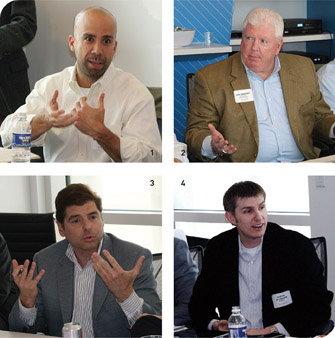
1. VML’s extensive efforts with brand-building for Gatorade had bolstered the company’s Facebook friends count by a factor of 10 in just a year, said Brian Yamada. | 2. Rob Sweeney noted that many companies advertising through mobile platforms still hadn’t figured out who they were trying to reach, and why. | 3. Mobile technology has given the Kansas City Royals “instant metrics” with certain ticket-sales figures, said Mike Bucek. | 4. Social media outlets can generate tens of thousands of responses, so it’s important to know which ones are important to companies, said Dustin Jacobsen; for that reason, monitoring efforts should focus on priorititizing “noise” from those sites, rather than trying to filter it out.
Todd Decker of iModules made the case for having a plan in place at the outset, one that would allow the brand managers to respond instantly to feedback, anticipated or otherwise. “It’s no longer push. It’s not a pull. It’s interactive,” said Decker of the social media experience. “It’s real time, and you have to be ready for that.”
“As a marketer,” Kramer asked rhetorically. “Is it 24 hours of hell all day every day?” Her answer: “Yes. There’s never a time when you’re not on.”
Brian Yamada spoke to VML’s experience with Gatorade. When Yamada and colleagues started working with this “powerful brand” a little more than a year ago, the brand had fewer than 300,000 Facebook friends. Now it has nearly
3 million. As Yamada explained, the
brand managers shifted their strategy
from the traditional start-and-stop campaigns to a more fluid, interactive one. “Every day, 24/7, they’re constantly looking for ways to activate,” said Yamada.
Judging Effectiveness
In social media, one of the more pressing challenges is judging effectiveness. “What’s the ROI on it?” asked Matt Anthony. That is something that all ad agencies are faced with when they talk to the leadership of a company, the accounting and planning people especially.
“In our case,” said Mike Bucek of the Kansas City Royals, “when we run a campaign or something like that, we get instant metrics by how many tickets we sold.” Still, as he acknowledged, a sports franchise presents measurement problems beyond those faced by most companies as the marketers have no control over the product on the field.
He noted that a sports franchise where he’d previously worked had used social media extensively. “For example, we would alter our game presentation based on feedback that our fans would provide through social media,” Bucek said.
Brian Yamada agreed that some filtering mechanism was essential lest the organization be overwhelmed with less-than-relevant inputs. As he explained, there are tools available to help identify the areas of sentiment that are recurring at the highest volumes. What he and his colleagues have tried to do is further refine that input into three concerns and three actions that will be taken in response to those concerns. “In the reports,” he noted, “we try to distill down to get to the core actions and activities.”
Rob Sweeney, whose infrastructure company, textCaster, works with such clients as Notre Dame University, explained—and showed on his mobile device—how Gatorade taps into the Notre Dame sports audience with an ad linked from the school’s mobile Web site. The challenge, he noted, for both Notre Dame and Gatorade is to extract the most value out of that relationship.
In this multi-modal environment, John Styers of 3C Interactive explained how this challenge plays out. “Gatorade has to decide,” he said, “ ‘How do I micro-market a Notre Dame fan that has come to my site, and what do I do differently for that crowd that’s going to be unique to the folks that are coming in from Northwestern?’ ” This leads to a discussion of return on investment: how closely can managers fine-tune strategies for a particular micro-market and still turn a profit?
Screening Out Noise
In a useful metaphor, Matt Anthony compared the social media environment to Speaker’s Corner in London’s Hyde Park, where there might be 30 speakers standing on 30 soap boxes, all competing for an audience. Similarly, he wondered how companies were “deselecting noise from valuable communication.”
“It’s not so much about filtering out the noise,” Dustin Jacobsen of Barkley clarified. “It’s about prioritizing the noise.” Jacobsen acknowledged that the dollars are not unlimited, so it is important to address the hottest issues first.
One strategy at Sprint, Terry Pulliam explained, is to reach out to what she called “influentials.” To engage them, she explained, requires a mix of traditional and new media marketing.